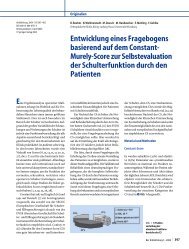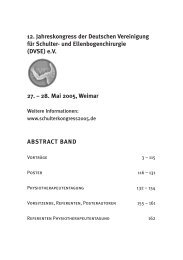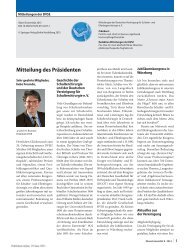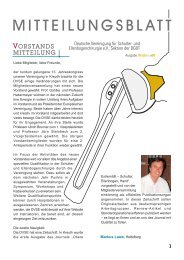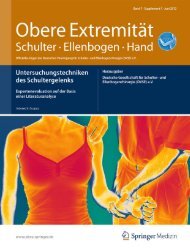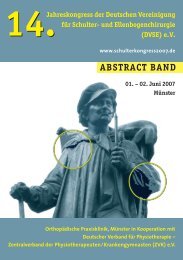Untersuchungstechniken des Schultergelenks - DVSE
Untersuchungstechniken des Schultergelenks - DVSE
Untersuchungstechniken des Schultergelenks - DVSE
Erfolgreiche ePaper selbst erstellen
Machen Sie aus Ihren PDF Publikationen ein blätterbares Flipbook mit unserer einzigartigen Google optimierten e-Paper Software.
2.6 Jerk-Test<br />
Beschreibung<br />
Der Jerk-Test (hinterer Apprehension-<br />
Test) dient der Testung der dorsalen Labrum-<br />
und Kapselstrukturen (. Tab. 10).<br />
Erstbeschreibung durch Hawkins et al.<br />
(1990). „The jerk test was performed by<br />
the senior author with all patients in a sitting<br />
position. While stabilizing the patient’s<br />
scapula with one hand and holding the affected<br />
arm at 90° abduction and internal<br />
rotation, the examiner grasps the elbow<br />
and axially loads the humerus in a proximal<br />
direction. The arm is moved horizontally<br />
across the body. A positive result<br />
is indicated by a sudden clunk as the humeral<br />
head sli<strong>des</strong> off the back of the glenoid.<br />
When the arm is returned to the original<br />
position, a second jerk may be ob served,<br />
that of the humeral head returning to the<br />
glenoid.”<br />
Abb. 30 8 Jerk-Test<br />
Tab. 10 Jerk-Test<br />
Autor<br />
Kim et al.<br />
2005<br />
Struktur Sensitivität<br />
(%)<br />
PPV Positiv prädiktiver Wert, NPV negativ prädiktiver Wert.<br />
Untersuchungstechnik<br />
Der Test kann sowohl stehend als auch sitzend<br />
durchgeführt werden.<br />
Der Untersucher steht schräg hinter<br />
der zu untersuchenden Schulter.<br />
Die Skapula wird mit dem Codman-<br />
Handgriff fixiert, während die andere<br />
Untersuchungshand die Schulter <strong>des</strong> Patienten<br />
in 90° Abduktion und 90° Innenrotation<br />
führt (. Abb. 30).<br />
Der Untersucher übt nun einen axialen,<br />
nach dorsal gerichteten Druck sowie<br />
gleichzeitig eine horizontale Adduktion<br />
auf den Ellenbogen <strong>des</strong> Patienten aus.<br />
Ein dorsaler Schmerz, ein apprehensiver<br />
Schultertonus oder die Angabe eines<br />
Instabilitätsgefühls werden als positives<br />
Testergebnis gewertet.<br />
Spezifität<br />
(%)<br />
PPV NPV<br />
73 98 0,88 0,95<br />
Literatur<br />
1. Hawkins R, Bokor DJ (1990) Clinical evaluation of<br />
shoulder problems. In: Rockwood CA, Matsen<br />
FA (eds) The shoulder. Saunders, Philadelphia,<br />
pp 149−177<br />
2. Kim SH, Ha KI, Park JH et al (2003) Arthroscopic posterior<br />
labral repair and capsular shift for traumatic<br />
unidirectional recurrent posterior subluxation of<br />
the shoulder. J Bone Joint Surg Am 85:1479−1487<br />
3. Kim SH, Ha KI, Yoo JC, Noh KC (2004) Kim’s lesion: an<br />
incomplete and concealed avulsion of the posteroinferior<br />
labrum in posterior or multidirectional<br />
posteroinferior instability of the shoulder. Arthroscopy<br />
20: 712−720<br />
4. Kim SH, Kim HK, Sun JI et al (2004) Arthroscopic capsulolabroplasty<br />
for posteroinferior multidirectional<br />
instability of the shoulder. Am J Sports Med<br />
32: 594−607<br />
5. Kim SH, Park JC, Park JS et al (2004) Painful jerk test:<br />
a predictor of success in nonoperative treatment<br />
of posteroinferior instability of the shoulder. Am J<br />
Sports Med 32: 1849−1855<br />
6. Kim SH, Park JS, Jeong WK, Shin SK (2005) The Kim<br />
test: A novel test for posteroinferior labral lesion of<br />
the shoulder − A comparison to the Jerk test. Am J<br />
Sports Med 33: 1188−1192<br />
Obere Extremität Supplement 1 · 2012 |<br />
29




